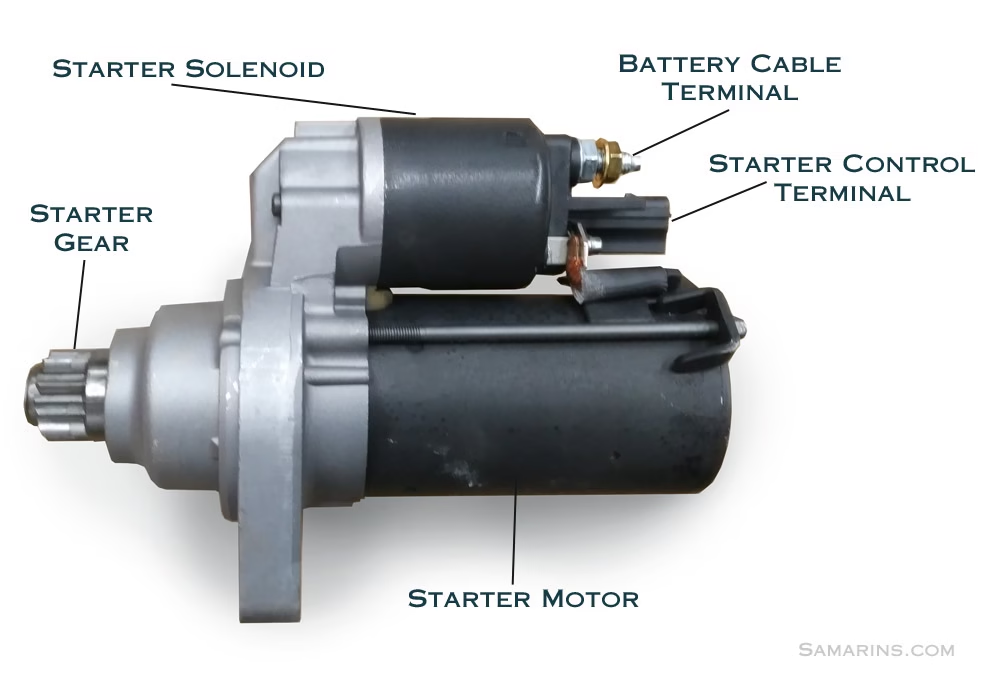
A car starter motor is a compact electric motor designed to crank an internal combustion engine to initiate its operation. When the ignition key is turned or the start button is pressed, the starter motor draws power from the car’s battery to rotate the engine’s crankshaft, creating the initial combustion needed for the engine to run independently. Typically, it engages the engine’s flywheel via a small gear called a pinion, which retracts once the engine starts to prevent damage. Image source: Samarins
Read these first:
- Know Your Car Basics 101: The Importance of Engine Oil and Oil Maintenance
- Know Your Car Basics 101: Faulty Dumb Car Keys, Almost End Spending RM950!
- Know Your Car Basics 101: Totally Wasted My Time When The Bloody Car Battery Died
- Know Your Car Basics 101: 4 Things I Learned On Car Maintenance
- Know Your Car Basics 101: Changing Faulty Bearing, Hub & Suspension
The Evolution of Car Starters
The history of car starters is a fascinating narrative that traces the technological advancements in the automobile industry. In the early days of the automobile, starting vehicles presented a significant challenge, as most cars were equipped with a hand-crank mechanism. Drivers needed to manually crank the engine to initiate the combustion process, which required considerable physical effort and skill. This method was not only labor-intensive but also posed safety risks, as incorrect cranking could lead to injury.
The introduction of the electric starter in the 1910s marked a significant breakthrough in automobile design. With the advent of electric starters, drivers could now start their vehicles with the simple turn of a key, drastically improving user convenience. The electric starter relied on an electric motor powered by the car’s battery, making it necessary for the battery technology to advance correspondingly. The 12-volt battery system, which became standard in the 1950s, significantly enhanced the starting power and efficiency of cars.
Another notable innovation came with the introduction of the solenoid. This electromechanical device serves as a relay that connects the battery to the starter motor when the ignition key is turned. The solenoid allowed for more efficient power management, improving the reliability of car starters. Over the decades, manufacturers have continued to enhance starter designs, including the development of gear reduction starters that provide higher torque while reducing weight. These advancements led to greater efficiency and longer-lasting components, allowing modern vehicles to start effortlessly even in adverse weather conditions.
Overall, the evolution of car starters reflects a continuous pursuit of enhanced reliability and efficiency in vehicle starting systems. As technology progresses, the changes in car starters not only highlight past innovations but also pave the way for future developments in the automotive field.
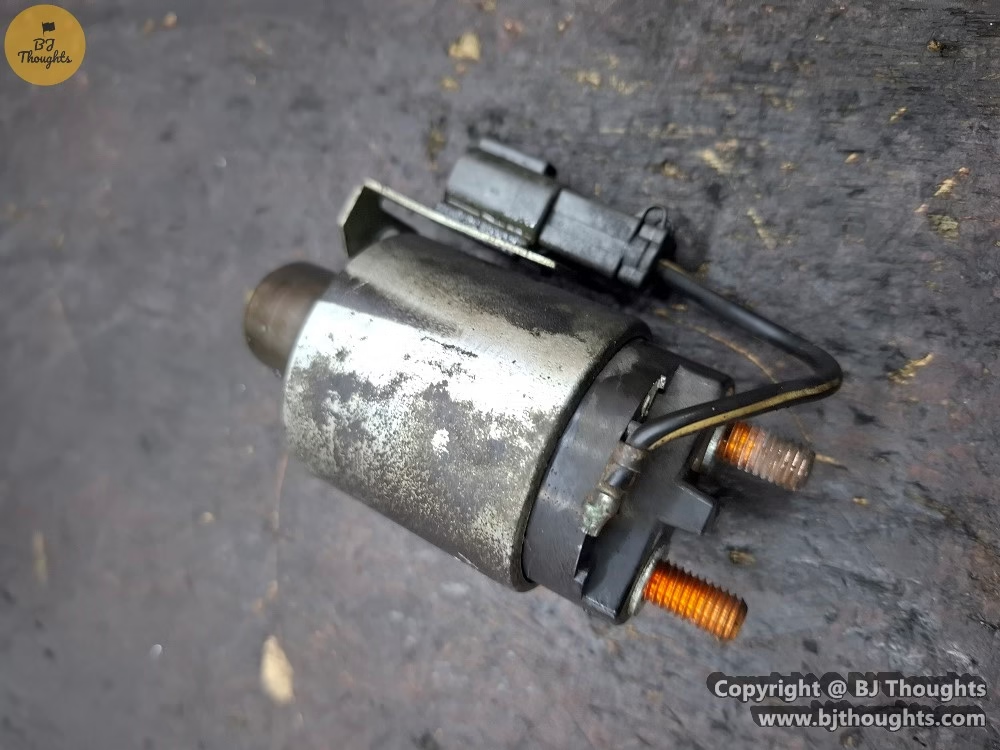
How Car Starters Work
The functionality of a car starter is pivotal for initiating the operation of the engine. At the heart of this system is the electric motor, which is responsible for physically cranking the engine when the ignition is activated. This electric motor is designed to provide high torque, enabling it to overcome the engine’s resistance during the starting process. Once the ignition key is turned, power is supplied to the starter motor, activating its internal components.
Another crucial component is the solenoid, an electrically-driven switch that plays a vital role in engaging the starter motor. When the ignition is switched on, the solenoid receives an electrical signal. This prompts the solenoid to move a plunger, which in turn engages the pinion gear with the flywheel of the engine. The pinion gear is a small gear attached to the end of the starter motor. Its proper engagement with the flywheel is essential; if the pinion gear does not mesh correctly, the engine will not start, and this can lead to further complications.
The starter relay also functions as an important intermediary in the starting process. It controls the high-current flow to the starter motor. When the ignition is energized, the relay closes the circuit, allowing significant amperage to pass through the motor. This relay ensures that the car battery conserves energy and prevents potential overload when starting the engine. In summary, the seamless interaction among the electric motor, solenoid, starter relay, and pinion gear allows the car starter system to perform its critical function of cranking the engine effectively, making it a cornerstone of automotive operation. Understanding these components provides essential insights into troubleshooting starter issues and maintaining vehicle reliability.
Common Starter Problems
Identifying issues with a car starter at an early stage is critical for preventing further complications within the vehicle’s electrical and ignition systems. Several symptoms can indicate that a starter is malfunctioning, and recognizing these signs can save both time and money.
One of the most common indicators of starter problems is the presence of clicking noises when the key is turned in the ignition. This sound often results from an insufficient electrical connection, which may stem from a weak battery or faulty wiring. In some cases, the starter solenoid may not engage properly, leading to the distinctive click without the typical engine cranking activity.
Another prevalent sign is when the engine fails to crank entirely. This situation can be particularly frustrating for drivers, as it often leaves them stranded. When turning the ignition switch results in no response, it is crucial to consider that it may not be solely a starter issue, as other components, such as the battery and ignition switch, should be examined as well.
Intermittent starting represents a less obvious but equally concerning symptom. This scenario occurs when the car starts normally one moment but fails to start the next. This inconsistency usually signifies that the starter is on the verge of complete failure, potentially leading to a no-start condition at the most inconvenient times. Ensuring that the starter functions consistently is vital for the reliable operation of the vehicle.
In conclusion, acknowledging these symptoms, such as clicking sounds, failure to crank, and intermittent starting, is essential for identifying starter problems early in their development. Monitoring these signs can lead to timely interventions and spare drivers the potential inconvenience of a complete starter failure.
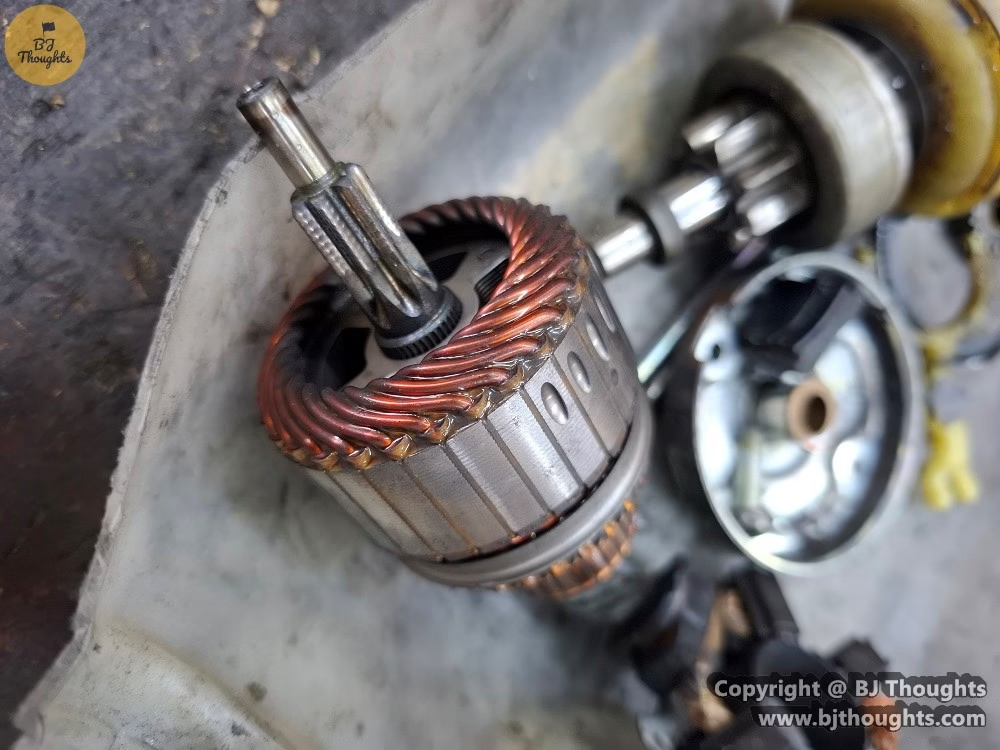
Diagnosing Starter Problems
Diagnosing starter problems in a vehicle can be an intricate process, but adopting a systematic approach can simplify the task significantly. The first step involves assessing the battery health. A starter motor requires adequate voltage to function effectively; thus, testing the battery’s charge is imperative. Utilize a multimeter to check the voltage. A healthy, fully charged battery should register around 12.6 volts; anything lower may indicate that the battery needs a charge or is faulty.
Next, examine the battery connections. Loose or corroded terminals can disrupt the flow of electricity, inhibiting the starter’s operation. Ensure that the connections are secure and free from corrosion, as this can often be a simple yet overlooked issue. If corrosion is present, cleaning the terminals with a solution of baking soda and water can be helpful. Once the connections are verified, proceed to inspect the starter motor.
Using the multimeter again, conduct a voltage drop test on the starter circuit. Attach the red lead to the positive terminal on the starter and the black lead to the starter casing, then have someone turn the ignition key to the start position. The reading should ideally be less than 0.5 volts. A higher reading signals an issue within the starter circuit, which could manifest as a resistive connection or a failing starter solenoid.
In addition to a voltage drop test, employing other diagnostic tools such as a test light can be beneficial. By connecting the test light to the battery positive and probing the starter’s terminals, one can determine if the starter is receiving power. If the light illuminates, but the starter does not engage, it usually indicates a malfunction within the starter motor itself.
Following these steps can streamline the diagnostic process for starter problems. Each procedure allows for the identification of potential issues systematically, ensuring an efficient approach to resolving starter-related challenges in vehicles.
Problems Affecting Car Starters
The reliability and performance of a car starter can be compromised by several potential problems, each of which can hinder the vehicle’s ability to start effectively. One of the most common issues is a weak battery. The car battery is essential for providing the necessary power to the starter motor, and if it is partially charged or nearing the end of its life, it may not supply adequate voltage. Symptoms of a weak battery include slow cranking or a clicking sound when trying to start the vehicle, necessitating either a recharge or replacement.
Another potential problem is a worn-out solenoid. The solenoid acts as a switch to engage the starter motor when the ignition key is turned. Over time, the internal components of the solenoid can wear out, leading to intermittent engagement or complete failure. This failure can manifest as a click without the motor turning over or a complete inability to start the car, which directly impacts the vehicle’s starting system.
Corroded connections are also a frequent cause of starter issues. Corrosion can occur at the battery terminals, solenoid connectors, or starter terminals, impeding the electrical flow required for the starter to function properly. This corrosion often arises from exposure to moisture or road salt, and it can lead to various symptoms, such as a dim dashboard light while cranking or a complete starter failure.
Lastly, motor failure can occur due to wear and tear, which may result from overheating or prolonged operation under strain. If the starter motor itself is damaged, the vehicle will show no response when attempting to start it. Identifying these potential problems early can significantly enhance the longevity and reliability of a car’s starting system, preventing unexpected breakdowns and ensuring smooth vehicle operation.
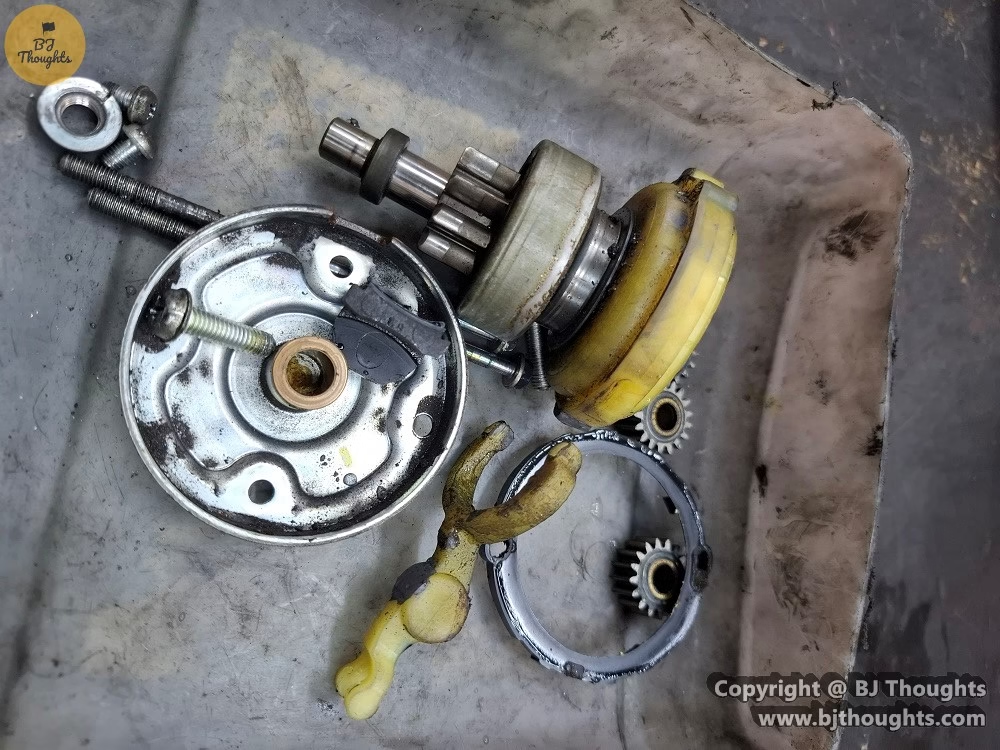
Troubleshooting Starter Issues
Troubleshooting car starter issues requires a systematic approach to accurately diagnose the problem. One of the first steps is to check for a blown fuse in the starter circuit. The fuse protects the electrical system from overloads, and if blown, the starter will not function. Locating the fuse box is essential; refer to the owner’s manual for its specific location in your vehicle. Once found, remove the corresponding fuse and inspect it for a break in the filament. If the fuse is damaged, replace it with one that matches the amperage rating before retesting the starter.
Another common issue can arise from loose connections. Over time, the wiring connected to the starter may become loose due to vibrations while driving. It is advisable to visually inspect the battery terminals and the connections attached to the starter. Ensure that these connections are snug; if they are loose, use a wrench to tighten them securely. Sometimes, corrosion can cause poor electrical contact, so it may also be necessary to clean the terminals gently with a wire brush before reconnecting.
Testing the starter relay’s functionality is another critical step. The starter relay acts as a switch and is essential for sending power to the starter motor. To test the relay, you can use a multimeter to check for continuity or even swap it with another identical relay in the fuse box if available. If the relay is indeed faulty, replacing it may resolve the issue.
If these troubleshooting steps do not yield results, or if you are unsure of the next steps, seeking professional assistance may be appropriate. Mechanics possess specialized tools and knowledge that can help identify and address more complex starter issues effectively. Addressing starter problems promptly can prevent further complications and ensure reliable vehicle operation.
Maintenance for Car Starters
Maintaining a car starter plays a crucial role in ensuring the reliability and longevity of a vehicle’s starting system. One of the first and most significant preventive measures is to regularly check the battery. A well-maintained battery provides the essential power needed for a starter to operate effectively. Automobile owners should monitor the battery’s condition, ensuring that terminals are clean, free from corrosion, and secure. Any signs of battery degradation, such as swelling or leakage, should prompt immediate replacement.
In addition to battery checks, it is vital to keep the connections associated with the starter clean and free from debris. Dirty or corroded connections can inhibit the flow of electricity, leading to starter failure or sluggish engine cranking. Using a wire brush to clean terminals and applying a protective spray can help maintain optimal contact. It is essential to inspect these connections periodically, particularly if the vehicle experiences starting difficulties.
Moreover, effective usage tips can extend the lifespan of a car starter significantly. It is advisable to avoid prolonged attempts at starting the engine, as excessive cranking can cause undue strain on the starter motor. If the engine does not start after a few seconds, it is prudent to pause and diagnose the underlying issue rather than repeatedly attempting to ignite the engine. Additionally, ensuring that the vehicle is in good working condition can reduce starter-related problems; regular maintenance checks on the ignition system and fuel delivery components contribute to smoother engine performance.
By adopting these preventive maintenance practices, automobile owners can minimize the likelihood of starter problems and enjoy a more reliable vehicle. Regular battery checks, meticulous care of connections, and responsible usage ensure a well-functioning starter system that can withstand the test of time.
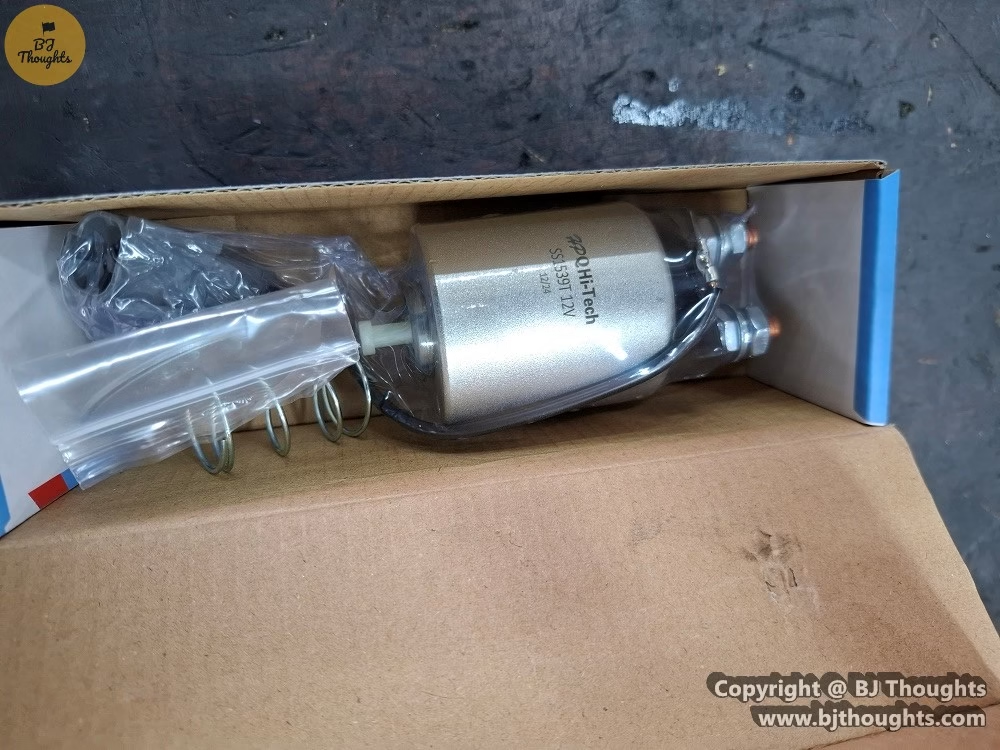
When to Replace Your Car Starter
Recognizing the signs that indicate a failing car starter is essential for maintaining your vehicle’s functionality. One of the primary indicators is the presence of a clicking sound when turning the key in the ignition. This sound typically signifies that the starter motor is not engaging properly, which may result from internal wear or electrical issues. Additionally, if your vehicle experiences intermittent starting problems, where the engine does not respond consistently, it may be a sign of a deteriorating starter system.
Another crucial factor to consider is the age and usage of your vehicle. Car starters generally have a lifespan of about 100,000 to 150,000 miles, though this can vary based on driving conditions, maintenance practices, and overall vehicle usage. If your starter has surpassed this mileage and begins displaying signs of malfunction, it may be prudent to consider a replacement rather than a repair.
Moreover, various environmental factors can impact the performance of your car starter. Extreme temperatures can affect battery performance and starter efficiency. In colder climates, for instance, battery capacity diminishes, which can place additional strain on the starter motor. If you find yourself needing to jump-start your vehicle frequently, it may indicate that both the battery and the starter need evaluation.
Cost considerations also play a significant role in the decision-making process. While repairs may seem more economical at first glance, if the costs begin to approach the price of a new starter, replacement becomes the more viable option. Overall, recognizing the signs, understanding contributing factors, and evaluating cost-effectiveness will empower car owners to make educated decisions regarding starter replacements, ensuring reliable vehicle performance.
Final Say
In conclusion, understanding car starters involves recognizing their historical evolution, fundamental components, and common troubleshooting techniques. The car starter has transformed significantly since its inception, moving from hand-cranked mechanisms to the advanced, reliable electric starters we rely on today. This progression has greatly improved vehicle starting efficiency and reliability, which are vital for any modern automobile owner.
Moreover, the key components of a car starter system, including the starter motor, solenoid, and ignition switch, play critical roles in ensuring the engine engages smoothly. Familiarity with these components allows car owners to better comprehend the intricacies of their vehicle’s starting system and prepares them to address potential issues promptly. Common problems, such as a faulty solenoid or worn-out brushes, may be remedied with basic troubleshooting, although some instances may necessitate professional intervention.
As car owners, remaining proactive in vehicle maintenance is essential. Regularly checking the starter’s condition can help mitigate unexpected breakdowns and enhance the overall longevity of the vehicle. Implementing preventive measures, such as battery maintenance and ensuring proper electrical connections, can greatly reduce the likelihood of significant starter issues arising. It is advisable to periodically consult a professional mechanic for comprehensive assessments, particularly if unusual sounds or performance inconsistencies are noticed when starting the engine.
In light of the information shared throughout this blog post, readers are encouraged to take ownership of their vehicle maintenance practices. Whether performing routine checks themselves or seeking expert assistance, applying the knowledge gained about car starters will undoubtedly lead to better vehicle performance and reliability. Ultimately, understanding this critical automotive component empowers car owners to make informed decisions regarding their vehicles.